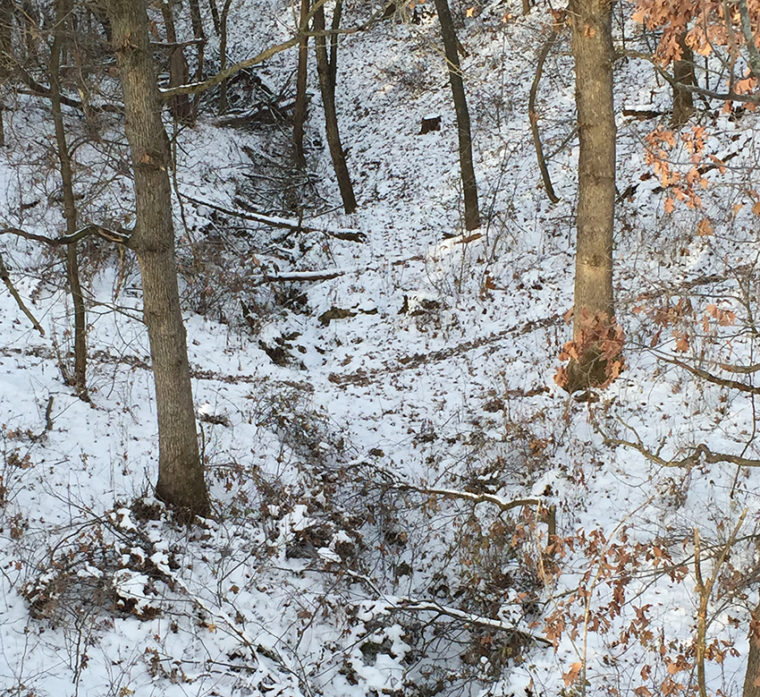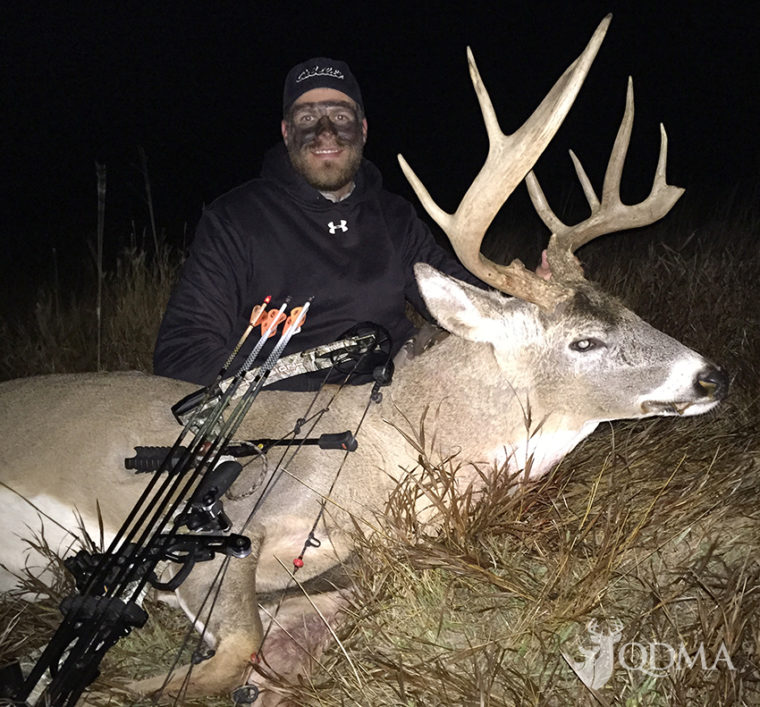You’ve likely heard advice about finding the does during the rut to find the bucks. Great advice, but let’s dig a little deeper into how you can put bucks in front of you during the rut. I have successfully used different types of bottlenecks or pinch points when hunting during the rut in different landscapes around the country. Here are three real-world stands I have hunted that provide examples in three different regions of the whitetail’s range, but the strategy behind each of them can be applied almost anywhere.
Wide Open Spaces
One of my favorite states to hunt is South Dakota, on the Great Plains where the wind howls and trees are few and far between. You don’t have to go far to find wide open prairie, crop fields, sloughs and shelterbelts (or bands of trees planted as windbreaks). The landscape offers a mix of natural and man-made bottlenecks, including some that are not obvious or even visible – what looks like a wide open space to the human eye is perceived and navigated much differently by deer. When you see cattle pasture and crop stubble for miles, it can be a bit overwhelming figuring out how to put yourself in a position to get a shot at a mature buck.
During the rut a buck looking for a receptive doe has a chance of finding a lady friend where the does are feeding, bedding and everywhere in between. So if you can pinpoint 1) destination food sources where deer are spending a lot of their evening and overnight hours and 2) where they head back to hole up for the day, you’ve won half the battle.
Shelterbelts are used for thermal cover and travel corridors. Typically these planted rows of cedars, junipers and other species are the only trees for miles, so they were loaded with scrapes and rubs. I have harvested bucks cruising these tree plantings. Many would walk the downwind side and let their nose tell them what deer were in the trees, while I’ve seen others walking down the middle of the belt, freshening rubs and scrapes.
The example below featured a ground blind set up in a gap in a shelterbelt. To the west lay a crop field, and to the east was a pasture with a creek meandering through it and a field of warm-season grass.
The shelterbelt acted as a bridge between the destination food source (crop field) and bedding cover (wetland vegetation along the creek plus the warm-season grass field). A road from the south provided an access route to the blind. A north wind was the ideal wind for hunting this blind. I was hunting this ground blind when I killed the buck in the photo at the top of this page.
In open country like this, any obvious cover will attract deer, but knowing how they navigate when they are not close to obvious cover can be the difference between filling a tag and going home empty-handed. I have witnessed bucks frequenting the downwind side of native warm-season grasses, wading through the tall grass searching for bedded does.
Similar to topography features, man-made barriers like fences and gate openings can pinch deer down. I don’t know how many times I’ve been driving down the road and noticed bucks cruising or chasing does down fence lines. Other less obvious bottlenecks include low-lying areas or swales deer use as travel corridors to get from point A to point B. Observation in open country is key: spend time glassing these areas to spot these hidden bottlenecks.
Big Woods
Big timber can be intimidating. It is hard to narrow down stand locations compared to the obvious creek crossing or cornfield edge you find in many parts of the whitetail’s range. I grew up hunting big tracts of public land in Northern Minnesota, and some days I wouldn’t even see a deer. When my dad and I would strategize about where to hang stands we were always thinking about setting up where we would see the right deer. Where would a mature buck cruise through this area, and why would he choose that particular route? This part of Minnesota was boreal forest consisting of aspen, birch, spruce-fir and pines. Where do you even start?
We had success hanging tree stands in spots where subtle changes in terrain would funnel cruising bucks. Keep in mind these are not always the obvious, textbook, hour-glass shaped bottlenecks. A perfect example of this was a spot I had dibs on for many years starting when I was old enough to hunt, seen in the map below.
The treestand was right above a fairly busy ATV trail, it faced south looking down an opening in a pine plantation that made a great shooting lane. Directly north of the stand was a little wetland. This small acre or two of standing water was nothing I couldn’t walk across with knee-high rubber boots, but it was enough of a deterrent it channeled bucks around the west side of it as they attempted to scent check the pines for does. This stand was in the money spot with any south wind. Eventually they would cross my shooting lane as they worked that southerly wind to their advantage. This was also a route deer would take to avoid other hunters. When others were running late to their spots, they would kindly send deer right to me!
We would also take advantage of clearcut areas or slashings in the years following a timber harvest or thinning. As these areas begin to regenerate, deer love the new growth for browse and bedding cover. Sort of serving as a “food plot,” these areas will attract deer. They create an opportunity for you to setup on the down-wind side in an attempt to intercept cruising bucks following the edge, scent-checking the slashing for a hot doe.
Mixed Agriculture/Timber
Many hunters find a decent deer trail or obvious fence crossing, and this is where they will spend the majority of their deer season. This can work, but sometimes you have to put a little more thought into it. How many times has the mature buck you’ve been targeting come strolling down the main trail right to you like the parade of does and younger bucks did an hour earlier? If you just answered “all the time” in your head, well, you have it figured out and should continue doing what you’ve been doing. It doesn’t work that way for me very often.
I’ve found similar sign and done the same exact thing just to find out X marked the spot a couple hundred yards away. Through trial and error and hunting the same area for a number of years, you can learn a lot. I have found success by locating the spots on that deer trail where it converges with other distinct trails. Many of these trail convergences happen because of a terrain feature. For example: a washout or ravine. If the sides of the ravine are steep enough, a majority of deer will cross at the top or bottom of ravine, like in the setup below.
Deer are lazy like us. Sure they can be down and back up out of that ravine in a few leaps and bounds, but they don’t want to work that hard if they don’t have to. Think about that nicely manicured shrub-hedge you walk around as you follow the sidewalk to the door of your favorite restaurant. Sure, you could go through it or over it with a little effort, but why would you put in the extra work? Not to mention you’d get some weird looks.
Sometimes you can create or enhance little opportunities like this with just a little extra creativity. In the photo below, notice the hinge-cut or fallen trees that make this ditch a little more difficult to cross – except at one location where it’s very easy. Notice the trail?

Strategically placed brush help funnel deer to cross this ravine at a single point, setting up an effective stand site.
Parting Pointers
You can do things to stop deer from using a certain trail and encourage the use of another. I have attempted with some success to hang several strings of fluorescent orange ribbon across deer trails trying to steer deer where I wanted them. I know guys who have gone as far as manipulating their private property by strategically placing downed trees and building fence with gate openings to direct traffic within bow range of their stands.
Learn to read topography maps and ground-truth what you are interpreting on the map. You will soon have a much better understanding of how and why deer navigate the area you are hunting.
When you find an old dilapidated wooden treestand or shooting shack, investigate why someone took the time to construct it where it is. Oftentimes it was there for a good reason. It is probably a historically productive spot during the rut.
I always enjoy hunting new places, as it challenges me to use a base of white-tailed deer and hunting knowledge I have built mostly through being taught by guys like my dad who were harvesting mature bucks before it was “cool,” reading articles from people who know a heck of a lot more than me, and trial-and-error. You can apply this base of whitetail knowledge anywhere you can hunt white-tailed deer. It is still a whitetail you are hunting no matter where you are. Good luck this season!



